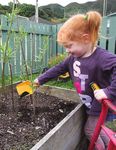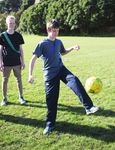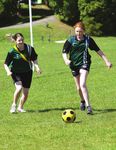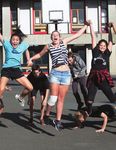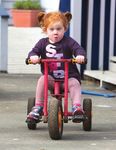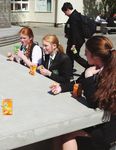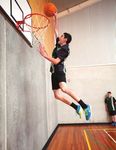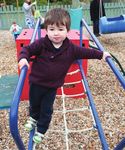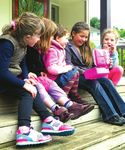FOOD, NUTRITION AND PHYSICAL ACTIVITY IN NEW ZEALAND SCHOOLS AND EARLY LEARNING SERVICES - EFFECTIVE PRACTICE March 2017
←
→
Page content transcription
If your browser does not render page correctly, please read the page content below
FOOD, NUTRITION AND PHYSICAL ACTIVITY IN NEW ZEALAND SCHOOLS AND EARLY LEARNING SERVICES EFFECTIVE PRACTICE March 2017
Food, nutrition and physical activity in New Zealand schools and early learning services: Effective practice Published 2017 © Crown copyright ISBN 978-0-478-43850-5 Except for the Education Review Office’s logo used throughout this report, this copyright work is licensed under Creative Commons Attribution 3.0 New Zealand licence. In essence, you are free to copy, distribute and adapt the work, as long as you attribute the work to the Education Review Office and abide by the other licence terms. In your attribution, use the wording ‘Education Review Office’, not the Education Review Office logo or the New Zealand Government logo.
Contents
Overview 4 Appendix 1: Methodology 45
Introduction 5 Data collection 45
What ERO found 10 Appendix 2: Food, nutrition and physical activity in previous ERO reports 46
Summary of overall findings 11 Early learning services 46
Primary schools 46
What were schools and services that were very good at promoting positive
attitudes to food, nutrition and physical activity doing? 12 Secondary schools 47
Planning and implementation 12 Appendix 3: Schools and services in this evaluation 48
Values and vision 12 Early learning services in this evaluation 48
Leaders’ and teachers’ actions 16 Primary schools in this evaluation 49
Environment 21 Secondary schools in this evaluation 50
Internal evaluation for improvement 26
Young people’s learning and participation 28
Young people knowing and valuing 28
Children and young people participating 33
Children and young peoples’ decision making 37
Whänau and community involvement 39
Parents and whänau 39
Conclusion 44
Food, nutrition and physical activity in New Zealand schools and early learning services: Effective practice 3Overview
In June 2015 the Cabinet Strategy Committee invited the Minister of Health, This report complements ERO’s Food, nutrition and physical activity in
in consultation with other Ministers, to report back to the Cabinet Social New Zealand schools and early learning services: Findings report. The findings
Policy Committee with recommendations on a proposed package of initiatives report is available online, and provides an overview of the findings and the
relating to childhood obesity.1 characteristics that supported schools and services to do well.
The resulting Cabinet Paper noted that the Education Review Office would ERO found that most schools and services were doing a good job of equipping
produce a national report assessing ‘the current status of food, nutrition, young people with the knowledge, skills and attitudes to make healthy choices
and physical activity in schools and early childhood services’, and would around food, nutrition and physical activity.
also report on findings about those Health Promoting Schools (HPS) included
in the evaluation sample. Young people told ERO that even though they knew what to do, they were
not always able to make these healthy choices. Environmental and financial
ERO gathered information about 202 early learning services during their constraints limited their ability to participate in physical activity. They were
regular education reviews during Term 1, 2016. A further 46 primary schools restricted in their ability to make healthy nutritional choices by the food that
and 29 secondary schools were reviewed with an evaluative focus on food, was available to them, either as a result of what was affordable, or what their
nutrition and physical activity. Primary schools were visited during Term parents chose to provide.
1, 2016. Secondary schools were visited during Term 2, 2016. Further
information about how the schools were selected is in Appendix 1. Schools and early learning services can teach children and young people
to value healthy food, nutrition and physical activity. To effectively change
In each school and service, ERO asked: behaviour, parents, whänau, local government and the wider community
needs to work together to support children and young people with
How well does the service/school promote positive attitudes to physical opportunities to make the best choices for their health and wellbeing.
activity and food and nutrition to benefit children?
This report gives examples of effective practice for supporting children and
young people’s learning about food, nutrition and physical activity. It includes
examples of common challenges faced by services and schools, and ways
leaders and teachers have found to respond to these challenges.
1 Cabinet Paper to Cabinet Social Policy Committee – Office of the Minister of Health [HR 20151468]
October 2015.
Food, nutrition and physical activity in New Zealand schools and early learning services: Effective practice 4Introduction
Obesity and more specifically, childhood obesity, is a concern of governments Activity in children aged 0‑5 years promotes healthy development, and
and other organisations internationally. One-third of New Zealand children are reduces the risk of them becoming overweight or obese.6 The food, nutrition
either overweight or obese. The issue of obesity is especially significant for and physical activity (F, N and PA) attitudes and behaviours children develop
Mäori and Pacific children, and those from disadvantaged backgrounds.2 while young persist into adulthood7 so it is important to establish healthy
Mäori and Pacific children are more likely to be overweight or obese, but habits when children are young.
researchers found these differences disappeared when they accounted for
socio‑economic status.3 Mäori and Pacific children are more likely to live in
low income households than children of other ethnicities.4 Physical activity
Physical activity includes all the movements people make in everyday
The environment a person lives in, and the way their bodies and behaviour life, including work, recreation, exercise and sporting activities.*
respond to that environment determines whether or not they will become Physical activity can provide a context for learning, or contribute
obese. Parents can increase the risk of obesity to their children through to an outcome, such as developing specific motor skills.
genetics and the environmental conditions before and during pregnancy.
Sport NZ (2014). Primary school resources. Retrieved 04.08.16 from
*
As they grow, children experience environments that include cheap, readily www.sportnz.org.nz/managing-sport/search-for-a-resource/guides/primary-school-resources
available foods that are high in energy and low in nutrients. They are less
physically active, both for transport and play, than in the past. These factors
influence whether the child becomes obese or not.5
2 Ministry of Health. Obesity data and stats. Retrieved (21.06.16) from
www.health.govt.nz/nz-health-statistics/health-statistics-and-data-sets/obesity-data-and-stats
3 Duncan, J. S., Schofield, G., Duncan, E. K., Rush, E. C. (2008). Risk factors for excess body fatness in
New Zealand children. Asia Pacific Journal of Clinical Nutrition, 17 (1), p. 138-147.
4 Mäori and Pacific children are also at a higher risk of persistent deprivation, and to experience severe
poverty. Carter, K. and Gunasekara, F. I. (2012). Dynamics of income in children in New Zealand, 2002‑2009:
A descriptive analysis of the Survey of Family, Income and Employment (SoFIE). Public Health Monograph 6 Oliver, M., Schofield, G. M., Schluter, P. J. (2010). Parent influences on preschoolers’ objectively
Series, 28. Retrieved (25.08.16) from www.otago.ac.nz/wellington/otago036608.pdf assessed physical activity. Journal of Science and Medicine in Sport, 13. p. 403-409.
5 World Health Organization (2016). Report of the commission on ending childhood obesity. 7 Waters E., Swinburn B., Seidell J. & Uauy R. (eds) (2010). Preventing Childhood Obesity.
Available from apps.who.int/iris/bitstream/10665/204176/1/9789241510066_eng.pdf?ua=1 London: Blackwell Publishing. p79.
Food, nutrition and physical activity in New Zealand schools and early learning services: Effective practice 5Young children who are overweight are five times more likely to be Young people’s physical literacy is developed by their experience of high
overweight at 12 years of age.8 The most consistent predictors of quality health and physical education, physical activity and sport. This physical
childhood obesity are: literacy gives them the motivation, confidence, physical competence,
>> low levels of physical activity knowledge and understanding12 they need to value participating in physical
>> unhealthy diet activity and sport across their life.
>> not enough sleep Young people spend approximately one-third of their waking hours at school
>> not eating breakfast.9 during term time, and sometimes even more than this in early learning
services. The education sector therefore has a key role to play in implementing
The recent World Health Organisation (WHO) report on Childhood Obesity,10
a curriculum that develops the nutritional13 and physical literacy of children and
points out the need for a cross‑sectoral approach to improving population
young people.
health and health equity. Using the compulsory school years to drive and
embed nutritional education is one important way of doing this. The report
also notes the need for inclusive physical education.11 It states that
interventions for children in early learning services support healthy behaviours
and weight trajectories, and these interventions are most effective when they
include caregivers and the wider community.
8 Lucas, P., & Schofield, G. M. (2009). Physical activity in the early childhood education centre
environment. New Zealand Research in Early Childhood Education Journal, 12, 125-136.
12 Whitehead, M. (2013) cited in Sport New Zealand (2015). Sport New Zealand’s Physical Literacy Approach:
9 Duncan, J. S., Schofield, G., Duncan, E. K., Rush, E. C. (2008). Risk factors for excess body fatness Guidance for quality physical activity and sport experiences. Available from www.sportnz.org.nz/about-us/
in New Zealand children. Asia Pacific Journal of Clinical Nutrition, 17 (1), p. 138-147. who-we-are/what-were-working-towards/physical-literacy-approach/
10 World Health Organization (2016). Report of the commission on ending childhood obesity. 13 Nutritional literacy is a person’s ability to obtain, process and understand basic nutritional information.
Available from apps.who.int/iris/bitstream/10665/204176/1/9789241510066_eng.pdf?ua=1 This literacy helps protect against risk factors such as socio-economic disadvantage, food insecurity,
11 Inclusive physical education provides opportunities for all students, of all abilities, rather than focused on nutritional status and body weight. Zoellner, J., Connell, C., Bounds, W., Crook, LaS., & Yadrick, K. (2009).
the potential elite sportsperson. See World Health Organization (2016). Report of the commission on ending Nutrition literacy status and preferred nutrition communication channels among adults in the Lower
childhood obesity, p31. Available from apps.who.int/iris/bitstream/10665/204176/1/9789241510066_eng. Mississippi Delta. Preventing Chronic Disease, 6, (4). Retrieved 7 December 2015 from www.ncbi.nlm.nih.
pdf?ua=1 gov/pmc/articles/PMC2774642/
Food, nutrition and physical activity in New Zealand schools and early learning services: Effective practice 6Physical activity has been linked with improved educational outcomes for Clear food policies and good education about nutrition can improve at-risk
students.14 Students that are more physically active and have higher fitness children’s nutritional status, help them build healthy eating habits, and learn
levels tend to spend more time on‑task and have higher levels of achievement. skills to support their decision making throughout their lives.20
In New Zealand, Sport in Education15 resulted in increased attendance, higher
student engagement and improved assessment results for secondary school
students.16 Sport
Sport can be informal or formal, competitive or non‑competitive forms
Similarly, evidence links good nutrition with improvements in both short and of active recreation.* It includes both new and established forms of
long-term educational outcomes.17 If children and young people do not have an active recreation, and can be used as a context for learning within
adequate intake of micronutrients, for example due to a high energy but low- The New Zealand Curriculum.
nutrient diet, their brains do not function optimally.18 Further evidence shows
*Sport NZ (2015). Community Sport Strategy 2015-20. Retrieved 04.08.16 from
that children who eat breakfast have improved test scores, and fewer days www.sportnz.org.nz/assets/Uploads/attachments/About-us/Com-Sport-Strategic-Plan.pdf
away from school.19
14 Centers for Disease Control and Prevention (2014). Health and academic achievement.
Available from www.cdc.gov/healthyyouth/health_and_academics/pdf/health-academic-achievement.pdf
15 Sport in Education is a Sport NZ project that supports schools to deliver the curriculum through the context
of sport. It is currently being developed, trialled and evaluated in eight secondary schools. It will be made
available to all schools. More information can be found at www.sportnz.org.nz/managing-sport/search-for-a-
resource/programmes-and-projects/sport-in-education-project
16 NZCER (2015). Getting runs on the board: Stories of successful practice from two years of the Sport
in Education initiative. Retrieved 04.08.16 from www.nzcer.org.nz/system/files/SiE-Getting-Runs-on-the-
Board.pdf
17 Ball, J., Watts, C., & Quigley, R. (2005). A rapid review of the literature on the association between nutrition
and school pupil performance. Wellington: Obesity Action Coalition.
18 Benton, D. (2001) cited in Ball, J., Watts, C., & Quigley, R. (2005). A rapid review of the literature on the
association between nutrition and school pupil performance. Wellington: Obesity Action Coalition.
19 Centers for Disease Control and Prevention (2014). Health and academic achievement. 20 Ball, J., Watts, C., & Quigley, R. (2005). A rapid review of the literature on the association between nutrition
Available from www.cdc.gov/healthyyouth/health_and_academics/pdf/health-academic-achievement.pdf and school pupil performance. Wellington: Obesity Action Coalition.
Food, nutrition and physical activity in New Zealand schools and early learning services: Effective practice 7The National Administration Guidelines (NAGs)21 set out expectations Health and Physical Education is a learning area of the NZC.24 This learning
for school administration. The NAGs state the boards of trustees must: area is broken into three subjects; health, home economics and physical
>> give priority to regular quality physical activity that develops education. It includes food and nutrition, and physical activity as two key areas
movement skills for all students, especially in Years 1 to 6 of learning. Managing self, an important part of managing health, is one of the
(NAG 1 (a)iii) key competencies of the NZC.
>> provide a safe physical and emotional environment for students
(NAG 5a) Physical education (NZC)
>> promote healthy food and nutrition for all students. (NAG 5b) Physical education is learning about “movement and its contribution
Both Te Whäriki and The New Zealand Curriculum (NZC) set out an to the development of individuals and communities. By learning in,
expectation that children should learn about health and physical activity. through, and about movement, students gain an understanding that
movement is integral to human expression and that it can contribute
The Ministry of Education (the Ministry) says physically active play supports to people’s pleasure and enhance their lives. They learn to understand,
learning across all strands of Te Whäriki. In particular, the Wellbeing (Mana appreciate, and move their bodies, relate positively to others, and
Atua) and Exploration (Mana Aotüroa) 22 strands have learning outcomes demonstrate constructive attitudes and values. This learning takes
relating to children learning how to control their bodies and keep themselves place as they engage in play, games, sport, exercise, recreation,
healthy. The Ministry have advice and ideas for supporting and providing adventure, and expressive movement in diverse physical and social
for physically active play, and explain the kinds of learning that can occur environments. Physical education encourages students to engage in
through play.23 movement experiences that promote and support the development
of physical and social skills. It fosters critical thinking and action and
enables students to understand the role and significance of physical
activity for individuals and society.”*
*
Ministry of Education (2007). The New Zealand Curriculum for English‑medium teaching and
learning in years 1‑13. (p. 23). Retrieved from nzcurriculum.tki.org.nz/The-New-Zealand-Curriculum
21 See www.education.govt.nz/ministry-of-education/legislation/nags/
22 Ministry of Education (1996). Te Whäriki, He Whäriki Mätauranga mö ngä Mojopuna o Aotearoa,
Early Childhood Curriculum. (p.48, 86). Retrieved from www.education.govt.nz/early-childhood/teaching-
and-learning/ece-curriculum/te-whariki/
23 Ministry of Education (2015). Play idea: Physically active play – Korikori. Retrieved 30 November 2015,
from http://www.education.govt.nz/early-childhood/teaching-and-learning/learning-tools-and-resources/ 24 Ministry of Education (2007). The New Zealand Curriculum for English‑medium teaching and learning
play-ideas/physically-active-play-korikori/ in years 1‑13. Retrieved from nzcurriculum.tki.org.nz/The-New-Zealand-Curriculum
Food, nutrition and physical activity in New Zealand schools and early learning services: Effective practice 8Learning about food and nutrition, and physical activity may also occur in other areas of the curriculum. For example, students may learn about nutrition in science, and about factors influencing involvement in physical activity in social sciences. ERO’s School Evaluation Indicators25 give a holistic view of desired outcomes for children and young people. One of these outcomes is for students to be physically active and lead a healthy lifestyle. Previous ERO evaluations have included information around how schools and early learning services developed children and young people’s knowledge and appreciation of health and physical activity. The findings of these reports are summarised in Appendix 2. 25 ERO (2016). School evaluation indicators: Effective practice for improvement and learner success. Available from www.ero.govt.nz/publications/school-evaluation-indicators Food, nutrition and physical activity in New Zealand schools and early learning services: Effective practice 9
What ERO found
ERO made a judgement about how well each school or service promoted Leaders and teachers may find it useful to consider the questions and the
positive attitudes to F, N and PA, from very well to not well at all. effective practice statements throughout the report when evaluating how their
The effective practice statements ERO used to make this judgement school or service promotes positive attitudes to F, N and PA.27
are found in each section of this report.
Information about the schools and services in this evaluation can be found in
Following a summary of the overall findings, this report is divided into three Appendix 3.
main sections. Each section begins with the questions ERO asked and the
effective practice statements used for making a decision about how well each Figure 1: The older the students, the less well food, nutrition
school or service was doing, followed by what ERO found in schools and
and physical activity was promoted
services that were doing very well. The sections include quotes.26 challenges
and examples of good practice. The sections cover the following aspects: Doing well Not doing so well
>> planning and implementation
Early learning
87% 13%
–– vision and values services
–– leaders’ and teachers’ actions
Primary
–– environment schools 74% 26%
–– internal evaluation
>> young people’s learning and participation Secondary
62% 38%
schools
–– knowing and valuing
Percentage of schools/services
–– participating
–– decision making
>> whänau and community involvement.
26 Quotes throughout this report are from leaders, teachers and young people at a range of services 27 Another useful resource for considering how schools promote wellbeing is ERO (2016). Wellbeing for
and schools. They were selected as being examples of comments made at the schools and services success: A resource for schools. Available from http://www.ero.govt.nz/assets/Uploads/Wellbeing-resource-
ERO visited. WEB.pdf
Food, nutrition and physical activity in New Zealand schools and early learning services: Effective practice 10Summary of overall findings
Early learning services Primary schools Secondary schools
Nearly nine out of ten services were doing well or very Primary schools that were doing well were thorough in Just under two-thirds of secondary schools in this
well at promoting children’s positive attitudes to F, N and their planning and implementation. Nearly three-quarters evaluation were doing well or very well at promoting
PA. Leaders and teachers in these services recognised of the primary schools in this evaluation were doing well positive attitudes to F, N and PA.
and valued the importance of F, N and PA for children’s or very well at promoting positive attitudes to F, N and PA.
Passionate leadership and a clear vision for student
wellbeing and learning.
These schools were guided by sound policies and wellbeing drove coherent and well planned programmes
This recognition and valuing underpinned the way the procedures, founded on a clear vision for students’ across the schools that were doing well. Decisions
service operated at all levels. Leaders, teachers, parents, success. There was a focus on holistic wellbeing, and around what was done, and how it was done were
whänau and children all understood the importance of students’ enjoyment of activity was valued. This meant guided by achievement, participation and survey data.
F, N and PA and acted in ways that promoted children’s there was a high level of consistency across the school
These schools actively involved students in decision
knowledge and participation. in the messages students were receiving about F, N and
making, and expected that parents and the school would
PA. Teachers modelled healthy choices, and showed their
Leaders and teachers were knowledgeable and capable work together to promote students’ wellbeing.
enjoyment in being active.
in the area of F, N and PA. They were strategic and
Schools that were doing very well reviewed the options
proactive in their decision making, and the environment The curriculum in these schools also recognised the
for food in their school canteen. They reduced or removed
and resourcing supported children’s learning in this area. focus on, and valuing of, students’ holistic wellbeing.
the unhealthy options, especially those high in sugar.
Teachers were responsive to students’ interests and
Teachers modelled healthy choices and ensured that In some schools, the board of trustees subsidised the
needs, and planned well for students’ learning about F,
the messages children received were consistent across canteen in order to promote healthier food choices and
N and PA. All students were included in activities, and
adults, and across children’s age groups in the service. keep the canteen viable. School leaders recognised that
teachers found ways to respond to children’s physical
Teachers worked well with children’s parents and the ‘managing self’ is one of the key competencies of NZC,
and cultural differences.
community to support children’s learning. Children and so preferred to inform and guide students, rather
developed leadership skills, and had opportunities to Leaders were proactive and strategic. They had high than enforce rigid rules.
make decisions about physical health in their learning expectations for teachers and students, and acted to
Organised sport was the main way that students were
programme. support them to meet these expectations. They knew
active in secondary schools. In schools that were doing
teachers’ needs, and accessed professional learning
Services that were part of an umbrella organisation had well at promoting positive attitudes, participating was
and development (PLD) that matched their areas of need.
clear direction, expectations and support for teachers and seen as important, not just competing. Teachers knew
They used research and school data to review and
parents around food, nutrition and physical activity which who was active and who was not, and took steps to
evaluate for improvement. They made strategic
supported many of these services to do well. encourage everyone to be active. They provided a
resourcing decisions around programmes, equipment
variety of ways for students to be active.
and facilities, and were focused on finding solutions.
Leaders and teachers encouraged and supported parents
to be engaged in their children’s education and school
activities, for example by providing training on how to
coach or manage a sports team.
Food, nutrition and physical activity in New Zealand schools and early learning services: Effective practice 11What were schools and services that were very good at promoting positive attitudes to food, nutrition
and physical activity doing?
Planning and implementation
ERO asked “How well are food, nutrition and physical activity programmes planned and implemented?”
>> How are positive attitudes to food, nutrition and physical activity promoted in ECE Management/Board/leaders’ actions?
>> How does the curriculum respond to, and promote, positive attitudes to food, nutrition and physical activity?
>> How are teachers supported to have the professional capability to promote positive attitudes to food, nutrition and physical activity?
>> How does the service/school environment promote positive attitudes to food, nutrition and physical activity?
Values and vision
ERO's effective practice statements for values and vision:
Leaders recognise that physical activity, food and nutrition are important to Leaders and teachers recognise that physical play is a worthwhile activity
children’s holistic development. for children.
The school/service community has identified that health and wellbeing Leaders and teachers emphasise fun, participation (e.g. sportsmanship and
influence educational and social outcomes and vice versa. fair play) and skill development over competition.
Leaders and teachers recognise and value children’s social and cultural Policies and planning include health and wellbeing actions.
perspectives.
Food, nutrition and physical activity in New Zealand schools and early learning services: Effective practice 12Schools and services that were doing very well at promoting positive attitudes
to F, N and PA valued and focused on children and young people’s holistic Hauora
wellbeing or hauora. They saw that wellbeing was necessary for learning, Hauora is a Mäori philosophy of wellbeing that is often described by the
and that play and physical activity were a vehicle for learning. Leaders and model ‘Te Whare Tapa Wha’*
teachers understood that one way to support children and young people to
experience wellbeing was to help them develop their understanding and In this model, four dimensions of wellbeing are represented by the
attitudes towards physical health. These schools and services often also four walls of a wharenui, or meeting house. Each wall symbolises
valued environmental sustainability and restorative practices as ways to the elements necessary to sustain hauora or health and wellbeing.
explore healthy foods and ways of interacting, which helped foster children These dimensions or elements are taha hinengaro, taha wairua,
and young people’s wellbeing. taha tinana, and taha whänau.
These values were evident in policies, plans, guidelines and practice. Taha hinengaro focuses on mental health and emotions. Taha wairua
Leaders developed policies informed by research or expert groups, and input focuses on spiritual health. Taha tinana focuses on physical health and
from staff, parents and their community. These policies and guidelines clearly taha whänau focuses on the epicentre of one's wellbeing: whänau.
outlined expectations for practice, such as fruit being the only option for Each dimension influences and supports the others.
snacks. The clarity and explicitness meant teachers, leaders and parents had *
Durie, M.1994. Whaiora, Mäori Health Development. Auckland: Oxford University Press.
a shared understanding of what was expected, based on the values, policies
and plans.
The explicitness of policies and plans, and teachers’ shared understanding
and valuing of wellbeing meant practices were consistent across the school
or service. Young people received the same messages from all adults.
Food, nutrition and physical activity in New Zealand schools and early learning services: Effective practice 13Leaders and teachers believed physical activity and participating in
sport increased young people’s motivation and engagement in learning,
and this was evident in their actions.
Participation, fun, risk‑taking and ‘giving things a go’ were encouraged
more than competition.
The importance of the values and vision was clear
A principal said:
The skills, understanding and motivation required to live a healthy
lifestyle are inherent in the school culture from staff through to
parents and students. We build on the attitudes and beliefs that
children have about their health and then use these to develop
further skills and understandings which the children can practise.
Young people said:
We are the next generation and the current adults will be gone and
we will be the leaders and running New Zealand so we need to be fit,
well and healthy.
There are competitive and non-competitive events. You don't have
to be competitive to be healthy.
We are still growing up and we need to teach the ones coming
on next.
If you didn't have hauora you wouldn't be yourself.
The school seems very concerned about looking after our emotional
health and wellbeing, but don't realise how connected [it is] to our
physical health and what we put in our bodies.
Food, nutrition and physical activity in New Zealand schools and early learning services: Effective practice 14Examples of practice: bringing the values and vision to life
Early learning service Primary school (HPS) Secondary school
At this Playcentre, leaders are careful to ensure that all This school has hauora as an essential element of its Student wellbeing is a clear focus in this school,
adults have a shared understanding and commitment to learner profile. The principal strongly encourages this, and this is demonstrated in its values of Participation,
promoting children’s health and wellbeing. as she knows the school’s whänau understand and Respect, Inquiry, Diversity and Environment.
relate to it.
Their induction process is well thought out, and The school is part of a Sport NZ initiative to engage
supports adults to understand what the expectations Hauora is woven throughout the school – policies, students in learning and achievement through sport.
are at the service. Adults are provided with information priorities, curriculum design, timetabling, resourcing Teachers conducted an inquiry into the effects of
about food, nutrition and physical activity, then the and professional practice. students’ learning through sport, and found that the
centre policies are introduced and explained. initiative had a positive impact on students’ learning
The school leaders work with people in the community to
and attitudes to learning.
Training programmes for adults also promote food, develop initiatives and resources that support the hauora of
nutrition and physical activity. the students and their families. For example, the principal This knowledge, combined with the school values,
worked with the council and a local trust to develop a bike means teachers are proactive in ensuring all students
Adults share publications, recipes, ideas and activities
track in the school grounds. They purchased 50 bikes, so all have opportunities to participate in physical activity.
for promoting food, nutrition and physical activity.
students had opportunities to learn and practise their cycling, As a result, they have seen a large increase in the
Expectations for practice are stated clearly, and
and have fun. Coordinators teach bike riding and safety skills number of students participating in sport.
displayed throughout the service. For example,
and look after the bikes, so that everyone can have a turn.
adults are expected to promote healthy food options, They support participation by:
and role model healthy eating. Leaders expect that physical education should be fun, >> r egularly making the school gym available
regular and relevant to the students. They support teachers to students
Leaders make sure that food, nutrition and physical
to do this through resourcing and PLD. >> m
aking sure students know how to find out
activity policies are up to date and implemented.
Once a term, all the adults have a meeting where Teachers offer students activities such as dance, waka ama about the sporting opportunities available
they review the policies and brainstorm ideas. and surfing, as well as fundamental movement skills. They >> h
aving social teams alongside competitive teams,
This helps ensure that all the adults understand see this as the way to support students to value physical for students that do not have the time to train for
what to do, and that policies are responsive and activity. a competitive team
inclusive of all the children in the service. >> supporting students with fees and equipment
The board of trustees is committed to students’ hauora.
They have strategic goals for this, and the principal reports >> r egularly surveying students about their
on progress towards these goals. The board ensures participation, and refining opportunities based
policies have detailed expectations to guide practice, and on this feedback
that leaders’ roles and responsibilities are clearly defined. >> t raining senior students as sports coaches for
junior teams
Performance management is aligned to the strategic goals.
>> holding fun events, such as a mini Olympics.
For example, some teachers will be appraised against
their progress towards developing the confidence to teach
physical education skills, not just having kids running around
the field.
Food, nutrition and physical activity in New Zealand schools and early learning services: Effective practice 15Leaders’ and teachers’ actions
ERO's effective practice statements for leaders’ and teachers’ actions:
Leaders and teachers include children in developing expectations of Leaders and teachers are familiar with developmental ages and stages, and
behaviour, and model these expectations. provide comfortable, safe spaces appropriate to children’s developmental
needs; in particular, for developing foundational physical skills.
Leaders and teachers create an environment where all children are included
and equally accepted. Leaders and teachers provide opportunities for all children to be involved
in sports through modifications that make it safe to play and yet still
Teachers have expectations that children will treat each other with respect challenging for participants.
and fairness.
Teachers support children to develop a wide range of physical activity skills
Leaders and teachers encourage children to be physically active on a that lead to increased mastery, self-confidence and competence.
regular basis; either on their own, with friends or with whänau.
Physical activity, food and nutrition in the curriculum promote children’s
Teachers respect children’s rights to be informed and/or consulted about wellbeing beyond the classroom.
decisions that affect them.
Leaders support ongoing PLD in the area of physical activity, food and
nutrition for teachers according to their specific needs.
Leaders and teachers had a clear understanding of the importance of F, N and Many schools and services used external facilitators to support their
PA for learning and wellbeing. They modelled positive attitudes, and showed physical education curriculum delivery. These facilitators provided
their enjoyment of healthy eating and activity. They participated in games with programmes that focused on sports’ skills development and the social
and against students, ensuring these activities were fun. aspects of working in a team. Leaders in schools and services that were
doing very well expected teachers would take what they learnt from these
Leaders supported staff to share consistent messages and made sure staff facilitators and use this in their own lesson delivery. Curriculum leaders
were able to access professional learning and development (PLD) programmes supported teachers to do this, and for some, this was an aspect of their
that built on their skills. They modelled their expectations appraisal.
and were strategic and deliberate in their decision making.
Food, nutrition and physical activity in New Zealand schools and early learning services: Effective practice 16Teachers integrated opportunities to learn about F, N and PA into other areas
of the curriculum. For example, children in one service were interested in Young people saw that leaders and teachers cared
how colours changed when blended together. Their teachers thought about
ways to explore this interest, as well as promote positive attitudes to nutrition. Principals said:
They decided to blend different coloured fruits and vegetables together into Prioritise things that work – then people will back it. Lead by example –
healthy smoothies. This gave them an opportunity to talk about healthy food Drive the bus! It's about finding the passions of the staff to drive each
choices, as well as explore the children’s interest in colour blending. aspect.
Programmes where children grew their own food were especially common I can't help what a parent puts in the lunchbox but I can educate the
in services. These were opportunities for children to learn a wide variety student about what is good to eat.
of skills, and develop their understanding of fruit and vegetables and their
Even though students are aware, they can’t change what’s in the
impact on health. Children were involved in deciding what to plant, nurturing
fridge.
the plants, harvesting, preparing and eating the produce. Teachers talked to
children about ‘growing food’ as food that is grown, and helps children to
grow. Teachers noticed children were much more willing to try new foods if Young people said:
it was something they had helped grow and prepare. We run clubs at lunchtime like the Wednesday walkers and the fun
runners with teachers.
Teachers knew young people’s interests, strengths and areas that needed
support. Children and young people’s developing skills, confidence and We go to the health group and take part in those meetings with
attitudes to F, N and PA were captured in learning stories and assessment. teachers.
This helped teachers to know each child’s current level of ability. Our school wants us to be healthy so they check we have fruit
They responded to this in their planning and provision. They made sure their and veges.
equipment and activities were appropriate, so each child or young person We learn about safety, risk taking and history as well.
could be involved. They scaffolded children’s learning and skills development
He [the principal] lets the teachers come out and play.
so they could all improve from the level they were at.
Food, nutrition and physical activity in New Zealand schools and early learning services: Effective practice 17Leaders and teachers made deliberate decisions about monitoring and Health Promoting Schools (HPS)29 supported some schools to take a more
regulating children and young people’s lunches. They were aware of the focused approach to the way they promoted student wellbeing. It helped
balance needed between promoting healthy food environments, and them develop the vision and values to support children and young people’s
maintaining relationships with children and their parents. Secondary school wellbeing, and monitor their progress towards goals. Primary schools30 that
leaders also considered how ‘policing’ food impacted on students’ ability to were part of HPS were doing a better job than primary schools that were not
self‑manage. Many teachers monitored children’s food, and steered them part of HPS.31 Schools that were doing very well, and not part of HPS, were
towards healthier options. One principal was concerned that being strict with doing similar things to those that were doing very well and were part of HPS.
monitoring lunchboxes was not productive, as the students had limited control
over what they brought and some parents resented any perceived criticism of ERO visited seven secondary schools that were HPS. Three of these
the lunches they provided. schools had a strong focus on student wellbeing, and were doing very well
at promoting positive attitudes to F, N and PA. At one of these schools,
In services, teachers encouraged children to eat the healthiest things from students were mainly responsible for HPS activities in the school.32
their lunchbox first. This was a way for them to have conversations about
what food was healthy and why, and to support children to eat more nutritious For both primary and secondary schools that were HPS but not doing so well,
lunches. They reported that children shared these messages with their friends there had been changes in leadership and/or staff, which had led to
and families. the information about, and prioritising of, HPS being lost.
Participation in the Healthy Heart programme28 had supported some services’
provision for F, N and PA. It helped teachers and leaders to review how their
service promoted positive attitudes and messages, and to be specific in their
curriculum planning. It provided them with a framework and guidelines that
supported them in their practice.
29 Health Promoting Schools is a school community-led development. HPS facilitators help schools to work
with their communities to use their strengths to find solutions and so improve health, wellbeing and
educational outcomes for their students and whänau. Information about HPS can be found at hps.tki.org.nz.
30 ERO visited 16 primary schools and seven secondary schools that were registered as HPS as part of this
evaluation.
31 Differences in the distribution of judgements for HPS and non-HPS primary schools were compared using
28 The Healthy Heart Awards are an initiative from the Ministry of Health and the Heart Foundation. They the Mann-Whitney U test. The level of statistical significance used for all testing in this report was pSimilarly, in some services, changes in staffing and leadership meant it was difficult to keep expectations clear and messages consistent. In a few services not doing well, teachers’ lack of knowledge and valuing of F, N and PA limited their ability to plan and evaluate programmes for children. Schools and services with sound induction processes for staff and families used induction as an opportunity to share their policies and procedures to ensure expectations were consistent when new people joined their community. Primary school leaders noted their main challenge was teachers’ confidence and capability to deliver a curriculum that promoted healthy attitudes to F, N and PA. Some schools had developed very clear PLD programmes, with a skilled and dedicated person in charge of F, N and PA promotion. A primary school story later in this report gives an example of how one school built teacher capability and confidence after identifying through internal evaluation this was an area they needed to improve. Food, nutrition and physical activity in New Zealand schools and early learning services: Effective practice 19
Examples of practice: leaders’ and teachers’ actions
Early learning service Primary school (HPS) Secondary school
Children at this service for children up to 3 years old Children and teachers at this school are encouraged to Teachers at this school were committed to providing
were involved in a programme encouraging them to eat do a little bit more each time, as a way of enacting the safe opportunities for all students to be physically active.
fruit and vegetables. Teachers introduced this programme school motto The best we can be. Teachers worked with parents to support students to
after they noticed that a girl was interested in broccoli. meet their goals.
Teachers and leaders model healthy behaviours,
The girl had seen broccoli plants growing in the garden showing enjoyment of physical activity and nutritious One girl had spent time in hospital, and was not able to
of the early learning service next door. This sparked her foods. For example, the principal leads Zumba sessions. walk even short distances comfortably. In spite of this,
interest in growing and eating vegetables. The girl and Students appreciated this, and told ERO He’s a real good she wanted to take PE as a subject in Year 12.
her mother stopped and checked on the broccoli every dancer! and He never sweats in his suit! Other teachers
Her parents were concerned about this, but along with
morning when she arrived at the service. participate in games with and against the students.
her teachers, they supported the girl’s choice. Teachers
Teachers followed up the girl’s interest by having The school’s PE programme is modelled on the structure made sure that PE was skills focused, rather than sports
conversations with children about eating five or more of the Numeracy Programme. Students learn a skill, focused. They worked to make the units relevant to
servings of fruit and vegetables each day. practise it, learn strategies and then implement them students’ lives. They motivated and encouraged the girl
in games. to succeed, providing realistic but challenging
Parents got on board with this, and brought in fruit
opportunities for her.
and vegetables they had grown at home. Children had Food and nutrition in the school programme includes
a chance to try fruits and vegetables they had never opportunities to grow food, prepare and eat it. The highlight for this girl was achieving her goal to
tried before. Children use their produce to make things like feijoa complete a biathlon. This was carefully planned and
chutney and zucchini cakes. used as an assessment opportunity. She had trained
The teachers were knowledgeable about good nutrition,
hard and been prepared well by her teachers.
and were also enthusiastic about making healthy food Leaders support staff to develop their skills.
Her parents were delighted.
choices. Class teachers are released to attend off site training
programmes, and also receive coaching from other
They captured the children’s thinking and discussions
teachers.
around the fruits and vegetables, and growing food.
Teachers used this to make a wall display about fruit They have deliberately created a culture of acceptance
and vegetables and healthy food choices. and inclusion. The Friendship Squad started with a group
of senior students who were responsible for looking out
The wall display helped reinforce children’s learning,
for students who needed support. Students now naturally
as well as inform parents about healthy food choices.
step up to support their peers, encouraging them to
participate. Everything is as a team.
Food, nutrition and physical activity in New Zealand schools and early learning services: Effective practice 20Environment
ERO's effective practice statements for the environment:
Indoor and outdoor environments allow and motivate children to explore Leaders and teachers provide play environments that stimulate creativity,
and be physically active. imagination, decision-making and problem-solving skills.
Play and sports equipment is safe, appropriate and readily accessible. Leaders and teachers promote a healthy food and nutrition environment
consistent with what children learn in the curriculum. For example, food
provision, fundraising, etc.
Schools and services that were doing very well used the environment to Services had a variety of static and moveable equipment that provided
motivate young people to be active, and provided them with opportunities children with the opportunity to explore and adapt their environment in
to learn about food and nutrition in a variety of ways. Posters and displays ways that were interesting and challenging to them. Leaders and teachers
brought ideas and examples of healthy foods and recipes to the fore. ensured the equipment they provided promoted a variety of skills, such as
Fruit and vegetable gardens onsite gave children and young people ready fine and gross motor skills, balance, climbing, co‑ordination and upper body
access to fresh food for snacks, lunches and food technology programmes. strength.
At one service, cards around the garden prompted questions about what
was growing. Like many services, primary school children had spaces to ride their bikes,
scooters or skateboards. They too had a variety of spaces for different
Services were well resourced for children to be physically active. activities, such as courts, fields, adventure playgrounds and trees they
They had a variety of spaces and equipment to suit different ages, were allowed to climb. Secondary schools provided students with various
abilities and interests. There were safe spaces for infants to lie, roll courts, gym spaces and fields to be active.
and explore independently. Other spaces promoted responsible risk
taking and challenges for older children.
Food, nutrition and physical activity in New Zealand schools and early learning services: Effective practice 21Schools were well resourced with equipment that was readily available to
students. They were able to use the equipment for both directed and free‑play The impact of the environment was recognised
activities.
A principal said:
The physical environment was reported as a challenge for just under 10
percent of services for their provision of physical activity opportunities for If kids are involved in daily physical activity and the environment around
children. them encourages healthy food options, they will value physical activity,
food and nutrition.
The most common challenge was that the space available, even though it met
licensing requirements, limited children’s opportunities for running and other Young people said:
gross motor activities. Staff in services with this challenge but still doing very
We have nude food – you can't have wrappers.
well were conscious of this and found alternative spaces, sometimes offsite,
for children to be active. They made sure the equipment set out was changed Lots of people bring footballs and bouncy balls to school.
regularly, so the environment continued to be interesting and challenging for
We love games at playtime, there is lots to do.
children.
Leaders at nearly one in six primary schools, and just over one-quarter of Leaders reported the cost of healthy food and regular access to sporting
secondary schools found the size or nature of their grounds limited young opportunities was a challenge for secondary schools and their students.
people’s ability to be active. They did not have all‑weather facilities, or enough Costs included renting off‑site facilities to train and play, team fees, team
space for all young people to be active. Time on fields and playgrounds had to uniforms, sports equipment, travel to games and training camps, and the
be scheduled. cost of healthy foods.
Several schools had built partnerships with community sports associations
as a way to access better facilities for their students. These associations
supported the school by installing all‑weather surfaces or facilities, in return
for being able to use these facilities outside school hours. One primary school
had an assortment of rain jackets and gumboots, so that children could still go
outside to be active in wet weather.
Food, nutrition and physical activity in New Zealand schools and early learning services: Effective practice 22The food environment Most schools had healthy options available for students to purchase, and
Where schools and services provided food to children and young people, many had looked to improve their menus. Secondary schools were limited
they worked to make sure this was healthy. Some consulted with experts by their concerns that if students could not get what they wanted, at a price
in the community, or community health groups to design the menus. they were willing to pay, they would go offsite to local dairies and fast‑food
They promoted healthy alternatives for celebrations, such as fruit kebabs outlets. Healthy options tended to be more expensive, and students were very
for birthday celebrations, instead of cake. price sensitive. One secondary student told ERO that if their school canteen
changed the menu to no longer include the cheap, unhealthy options, there
Many primary schools had opportunities for students to purchase or be would be a lot of hungry and angry boys.
provided with food while at school. In many primary schools, students
were able to order lunches from outside providers. Some had canteens Some schools ran their own canteens, or had canteens run by volunteers.
or tuck shops, although fewer than in secondary schools. All but one of Unfortunately, many self‑run canteens lost money, so schools contracted
the secondary schools in this evaluation had a canteen or tuck shop. out the canteen to external providers. These providers were profit driven,
This school had vending machines accessible to students. and tended to be most interested in stocking what would sell well; not
usually the healthy options.
Fruit, milk, sandwiches and Weet-Bix were the main foods provided for
primary school students. Breakfasts and lunches were usually made available Boards of trustees in some schools recognised the effect of price on students’
to students who needed them. Some schools had taken steps to reduce purchasing decisions, and subsidised healthier options in order to make them
the perceived stigma of receiving food from the school. This included having more attractive to students. Another school renegotiated the terms of the
breakfast available to all students, or buying lunches for students in need contract with the provider, in return for the provider no longer selling soft
alongside regular lunch orders. Some secondary schools also had breakfast drinks.
clubs, although this was less common.
In spite of it being a successful fundraiser, most schools (both primary and
In both primary and secondary schools that were doing very well, schools secondary) did not sell chocolate as a way to raise money. They were aware
reviewed the food sold for lunches. They used expert advice and nutritional of the messages they were sending, and so considered alternative ways to
guidelines to support decision making around what food was available. In raise money, such as fun runs, activity days and quiz nights. Some still used
secondary schools, students also had a say in what was offered. sausage sizzles to fundraise. A few schools that were doing somewhat well
overall still used chocolate or cake stalls for fundraising.
Food, nutrition and physical activity in New Zealand schools and early learning services: Effective practice 23The environment around the school was a concern for many school leaders. Ready access to fast food and other unhealthy options was a challenge. Some parents provided unhealthy food for their children to eat at school. Students regularly bought unhealthy foods from local dairies, fast food outlets and petrol stations on their way to and from school, or, for some, they could visit these outlets at lunchtimes. Schools on busy roads found that students were not able to safely use active forms of transport to and from school, so would be dropped off by car or bus. While reducing students’ access to unhealthy foods, it also reduced their opportunities for incidental activity. Food, nutrition and physical activity in New Zealand schools and early learning services: Effective practice 24
You can also read
